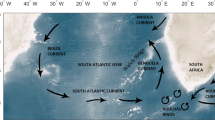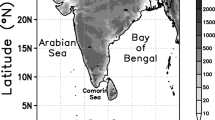Abstract
The data of the CTD survey conducted in the Denmark Strait and Irminger Sea in May–June 2009 are used to calculate the vertical profiles of the turbulent overturning scale, which are then used to estimate the dissipation and entrainment rates in the overflow plume. The resulting estimates of the entrainment rate varied widely from 2 × 10–7 to 7 × 10–3 m/s. It is shown that such a wide range of entrainment rates is caused by the intermittency of turbulence. Large turbulent overturning at the interface of the Denmark Strait overflow plume is detected on the vertical temperature, salinity, and potential density profiles.
Similar content being viewed by others
References
A. S. Monin and R. V. Ozmidov, Ocean Turbulence (Gidrometeoizdat, Leningrad, 1981) [in Russian].
R. V. Ozmidov, “Turbulence exchange in stabile stratified ocean,” Izv. Akad. Nauk SSSR, Fiz. Atmos. Okeana 1 (8), 853–860 (1965).
V. T. Paka, B. Rudels, D. Quadfasel, and V. M. Zhurbas, “Measurements of turbulence in the zone of strong bottom currents in the strait of Denmark,” Dokl. Earth Sci. 432 (1), 613–617 (2010).
K. N. Fedorov, Fine Thermohaline Structure of Ocean Water (Gidrometeoizdat, Leningrad, 1976) [in Russian].
L. Arneborg, V. Fiekas, L. Umlauf, and H. Burchard, “Gravity current dynamics and entrainment—a process study based on observations in the Arkona basin,” J. Phys. Oceanogr. 37 (8), 2094–2113 (2007).
J. G. Bruce, “Eddies southwest of the Denmark Strait,” Deep Sea Res., Part I 42 (1), 13–29 (1995).
R. R. Dickson and J. Brown, “The production of North Atlantic deep water: sources, rates, and pathways,” J. Geophys. Res., C: Oceans Atmos. 99 (6), 12319–12341 (1994).
T. M. Dillon, “Vertical overturns: a comparison of Thorpe and Ozmidov length scales,” J. Geophys. Res., C: Oceans Atmos. 87 (12), 9601–9613 (1982).
I. Fer, G. Voet, K. S. Seim, et al., “Intense mixing of the Faroe Bank Channel overflow,” Geophys. Res. Lett. 37, L02604 (2010). doi 10.1029/2009GL041924
J. B. Girton and T. B. Sanford, “Descent and modification of the overflow plume in Denmark Strait,” J. Phys. Oceanogr. 33 (7), 1351–1364 (2003).
G. C. Johnson, R. G. Lueck, and T. B. Sanford, “Stress on the Mediterranean outflow plume: Part II. Turbulent dissipation and shear measurements,” J. Phys. Oceanogr. 24 (10), 2084–2092 (1994).
G. C. Johnson, T. B. Sanford, and M. O. Baringer, “Stress on the Mediterranean outflow plume: Part I. Velocity and water property measurements,” J. Phys. Oceanogr. 24 (10), 2072–2083 (1994).
W. Krauss, “A note on overflow eddies,” Deep Sea Res., Part I 43 (10), 1661–1667 (1996).
T. Osborn, “Estimates of the local rate of vertical diffusion from dissipation measurements,” J. Phys. Oceanogr. 10 (1), 83–89 (1980).
V. Paka, V. Zhurbas, B. Rudels, et al., “Microstructure measurements and estimates of entrainment in the Denmark Strait overflow plume,” Ocean Sci. 9 (6), 1003–1014 (2013).
H. Peters and R. Bokhorst, “Microstructure observations of turbulent mixing in a partially mixed estuary. Part II: Salt flux and stress,” J. Phys. Oceanogr. 31 (4), 1105–1119 (2001).
H. Peters and W. E. Johns, “Mixing and entrainment in the Red Sea outflow plume. Part II: Turbulence characteristics,” J. Phys. Oceanogr. 35 (5), 584–600 (2005).
L. H. Shih, J. R. Koseff, G. N. Ivey, and J. H. Ferziger, “Parameterization of turbulent fluxes and scales using homogeneous sheared stably stratified turbulence simulations,” J. Fluid Mech. 525, 193–214 (2005).
M. A. Spall and J. F. Price, “Mesoscale variability in the Denmark Strait: the PV outflow hypothesis,” J. Phys. Oceanogr. 28 (8), 1598–1623 (1998).
S. A. Thorpe, “Turbulence and mixing in a Scottish loch,” Philos. Trans. R. Soc., A 286 (1334), 125–181 (1977).
L. Umlauf and L. Arneborg, “Dynamics of rotating shallow gravity currents passing through a channel. Part I: Observation of transverse structure,” J. Phys. Oceanogr. 39 (10), 2385–2401 (2009).
G. Voet and D. Quadfasel, “Entrainment in the Denmark Strait overflow plume by mesoscale eddies,” Ocean Sci. 6 (1), 301–310 (2010).
Author information
Authors and Affiliations
Corresponding author
Additional information
Original Russian Text © V.M. Zhurbas, V.T. Paka, B. Rudels, D. Quadfasel, 2016, published in Okeanologiya, 2016, Vol. 56, No. 2, pp. 221–229.
Rights and permissions
About this article
Cite this article
Zhurbas, V.M., Paka, V.T., Rudels, B. et al. Estimates of entrainment in the Denmark Strait overflow plume from CTD/LADCP data. Oceanology 56, 205–213 (2016). https://doi.org/10.1134/S0001437016020223
Received:
Accepted:
Published:
Issue Date:
DOI: https://doi.org/10.1134/S0001437016020223




